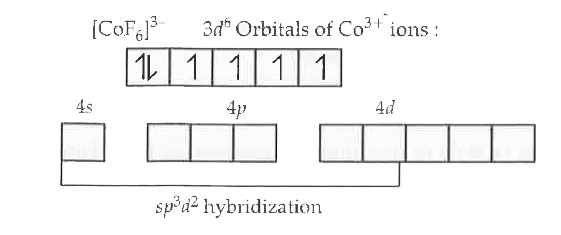Using valence bond theory explain geometry, hybridisation and magnetic property of [CoF6]−3 (Atomic number of Co = 27).Solution in Kannada

so, it possess octahedral geometry and paramagnetic in nature.
Topper's Solved these Questions
- CO-ORDINATION COMPOUNDSBOOK - OSWAAL PUBLICATIONCHAPTER - CO-ORDINATION COMPOUNDSEXERCISE - TOPIC-2 (WERNER.S THEORY BONDING IN CO-ORDINATION COMPOUND , VBT, CFT AND IMPORTANCE OF CO-ORDINATION COMPOUNDS) (Very Answer Type Questions)
19 Videos
- CO-ORDINATION COMPOUNDSBOOK - OSWAAL PUBLICATIONCHAPTER - CO-ORDINATION COMPOUNDSEXERCISE - TOPIC-2 (WERNER.S THEORY BONDING IN CO-ORDINATION COMPOUND , VBT, CFT AND IMPORTANCE OF CO-ORDINATION COMPOUNDS) (Very Short Answer Type Questions)
8 Videos
- CHEMISTY IN EVERYDAY LIFEBOOK - OSWAAL PUBLICATIONCHAPTER - CHEMISTY IN EVERYDAY LIFEEXERCISE - LONG ANSWER TYPE QUESTIONS-I
1 Videos
- D - BLOCK ELEMENTS F - BLOCK ELEMENTS BOOK - OSWAAL PUBLICATIONCHAPTER - D - BLOCK ELEMENTS F - BLOCK ELEMENTS EXERCISE - TOPIC - 2 (F - BLOCK ELEMENT , LANTHANOIDS AND ACTINOIDS)(LONG ANSWER TYPES QUESTIONS)
6 Videos
Similar Questions
Using valence bond theory (VBT), account for the geometry, type of hybridization and magnetic property of [NiCl4]2−.
View SolutionHow many cyanide ions in K4[Fe(CN)6] are involved in satisfying the primary valency of the central metal ion ?
View Solution(a) Why are detergents called soapless soap ?
(b) Why do soaps not work in hard water ?
View SolutionCompare the chemistry with that of the lanthanoids with special reference to (i) electronic configuration (ii) atomic and ionic sizes (iii) oxidation state (iv) chemical reactivity .
View SolutionValence bond theory explains the geometry and magnetic nature of the coordination compounds .
View SolutionExplain with the help of valence bond theory, the geometry and magnetic nature of [MnCl6]4−
View SolutionWith the help of valence bond theory (VBT) , explain hybridisation geometry and magnetic behaviour of (NiCl_4)^(2-) complex .
View SolutionOn the basis of valence bond theory, explain geometry, nature of hybridisation, magnetic property and optical isomerism of [Co(ox)3]3−and[CoF6]3−.
View SolutionWith the help of Valence Bond Theory (VBT) explain hybridisation, geometry and magnetic property of [CoF_6]^2 heat fluoridocobaltate (III) ion.
View SolutionExplain the hybridisation, geometry and magnetic property of [Ni(Cl)4]2−.
View SolutionWith the help of Valence Bond theory account for hybridisation, geometry and magnetic property of [Ni(CN)4]2− complex ion [Z for Ni=28]
View SolutionUsing valence bond theory explain geometry, hybridisation and magnetic property of [CoF_6]_3^- (Atomic number of Co = 27).
View SolutionExplain the hybridisation, mgnetic property, geometry, magnetic moment of [Ni(CO)4] using valence bondy theory.
View SolutionExplain the hybridisation, geometry, magentic property and magnetic moment of [Ni(CN)4]2− using valence bondy theory.
View SolutionUsing VB theory, explain the type of hybridisation , geometry , magnetic property and magnetic moment of [Fe(CN)_(6)]^(3-)
View Solution
